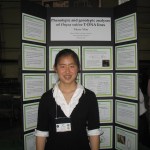genetics and society
Finally our paper is in press!
in the coming issue of PNAS, we describe a genome-scale model for predicting the functions of genes and gene networks in rice, an important staple food. Called RiceNet, this systems-level model of rice gene interactions allows us to effectively predict gene function. This information can be used to help boost the production and improve the quality of one of the world's most important food staples.
This graphic is a full-size view of a RiceNet layout, color-coded to indicate the likelihood of network links; red for higher and blue for lower likelihood scores…
Consumers are asking us many questions about biotech seeds and traits. They want to know why some farmers may choose to use them and what the long-term implications are not only for our health but also for the farming/ranching industry.
All of the challenges and issues facing the agriculture industry are very complex and multifaceted. The issue of using biotech seeds and traits is no different. U.S. Farmers & Ranchers Alliance (USFRA) has encouraged farmers and ranchers to share their experiences and provide some insight into why they choose - or choose not - to use biotech seeds.
They…
Strawberries are a particularly pest prone crop.
To control these pests, more than 9.5 million pounds of pesticides, including over 3 million pounds of methyl bromide, a toxic ozone-depleting chemical is applied each year. Methyl bromide is also associated with an increased risk of prostate cancer in farm workers.
We all like strawberries, but this pesticide use seems excessive: more pounds of pesticides were applied to 28,000 acres of strawberries than to 780,000 acres of cotton (and cotton is one of the world's most pesticide intensive crops).
To avoid contributing to the use of methyl…
Today I am in NYC participating in the "Food Dialogues", a discussion with farmers and ranchers in four US locations about food and farming. The program is sponsored by the US farmers and ranchers alliance.
Right now Secretary Vilsack is speaking with host Claire Shipman. He says "diversity makes sense..we need all kinds of agriculture (big, small, conventional, organic) to drive the rural economy. We need to try to figure out how to help all aspects of agriculture because agriculture helps all of us."
In an hour the NYC panel will answer questions about consumer issues.
Tune in to ask…
Generalizing about "GMOs" is almost completely useless. Each food we eat and each farm is so different that the genetic technologies and farming practices needed to optimize sustainability must be different too. That is why each crop (GE or conventional) must be looked at on a case-by-case basis, using science-based evidence.
I recently wrote a short Scientific American guest blog post for their "Passions of Food" day examining how cotton genetically engineered to express the organic protein Bt is affecting agriculture today. Thanks to Bora Zivkovic, former ScienceBlogger, for this…
This week, the G20 Agriculture Ministers gathered for their first-ever meeting to discuss potential measures to address price volatility and record high food prices. The key to any long-term solution is acknowledging that we need to empower the very people whose lives are most affected by food shortages. Three-quarters of the world's poorest people get their food and income by farming small plots of land. The potential of small farmers for getting us out of this and future food crises cannot be overstated.
Today, we find that millions of lives depend upon the extent to which agricultural…
The journalist Marc Gunther recently posted a thoughtful article discussing public perceptions of the role of organic agriculture in a future sustainable food system.
He found that many consumers believe that there are only two ways to produce food:
"The first can be described, depending upon who's talking, as big, fast, modern, conventional, industrial, intensive, chemical, genetically-modified, processed and global. It's the system that delivers most of the food that most Americans eat."
"The second is described as organic, sustainable, local, small-scale, family-owned, natural, agro-…
Alan Alda, award-winning actor and visiting professor at the Center for Communicating Science at Stony Brook University, talks about his experiences with communicating science to the general public. Looking to close the gap between the scientific community and the public, Mr. Alda discusses what needs to be improved, and how science can be better understood.
hat tip to (@DocCamiRyan)
Merry Mou won first place in the Synopsys Silicon Valley Science and Technology Championship. 700 to 900 students participate with their research projects in a variety of categories, including physics, biology, and computer science. Winners are chosen to go on to state and national competitions.
Merry Mou won 1st place in Botany in the 2010 Championship for her project, Phenotypic and Genotypic Analyses of Oryza Sativa T-DNA Lines, which was completed in the summer of 2010 as part of the Young Scholars Program under the guidance of postdoctoral fellow Manoj Sharma. She will be participating…
Today we took the children to Table Mountain, a volcanic mesa in northern California.
It is a special place, preserved from development by the dense, rocky texture of the soil- no good for farming. We strolled through carpets of flowers Lasthenia californica (California goldfields). Blemnosperma nanum (yellow carpet), Lupinus nanus, Triteleia ixiodies (pretty face), Castilleja exserta (purple owls clover), Triphysaria eriantha (Jonnytuck or Butter 'n' eggs), Eschscholzia caespitosa, (foothill poppy), popcorn flower and gaze at the box kites flying overhead. The blue, grey and white match the…
I walked into the gleaming 'Orchard in a box", a closed greenhouse where no pollen can flow outside. The apple was red, red, red inside and out and I wanted it. But because I was in New Zealand, where experimenting with genetically engineered food is highly regulated, tasting was banned.
How was this forbidden fruit created? By overexpression of an apple transcription factor in the white-fleshed, tasty Royal Gala variety. The transcription factor was isolated from an apple that has both red flesh and red skin, that occurs in Central Asia. However, these apples are normally quite bitter…
With religious wars around the world erupting almost constantly, you might be feeling grateful that you live in a country where there is separation of church and state. But dont rest too easy, another conflict is brewing- this time in agriculture.
Twenty years ago organic farmers in our area began growing specialty sunflowers to sell for cut flowers. Although most of the pollen from organic sunflowers does not travel further than 3 meters, some of it can travel up to distances of 1000 meters, which can cause problems for growers of certified sunflower seed. If stray organic pollen should…
DESPITE overwhelming evidence to the contrary, roughly one in five Americans believes that vaccines cause autism -- a disturbing fact that will probably hold true even after the publication this month, in a British medical journal, of a report thoroughly debunking the 1998 paper that began the vaccine-autism scare. says Michael Willrich, a professor of history at Brandeis University in todays NYT
Similarly, according to Dr Oz, the TV host, papaya genetically engineered with a snippet of a mild strain of a virus to make it disease free, causes infertility. This in face of overwhelming evidence…
On Monday afternoon, yours truly will appear with Dr. Oz, "America's doctor," (the tag bestowed on him by no less than Oprah Winfrey) before a live audience in New York City. Although I have never seen the show, a New York Times magazine article written by the brilliant Frank Bruni, suggests that the show, and Dr. Oz himself, are both pretty entertaining.
As one of the most accomplished cardiothoracic surgeons of his generation, Mehmet Oz has transplanted lungs and repurposed hearts; implanted mechanical devices to provide the pump and pulse for patients that cannot manage that on their own;…
The last common ancestor of plants and animals may have lived 1 billion years ago. Plants and animals have occasionally exchanged genes, but for the most part, have countered selective pressures independently. Microbes (bacteria, eukaryotes, and viruses) were omnipresent threats, influencing the direction of multi-cellular evolution. Receptors that detect molecular signatures of infectious organisms mediate awareness of non-self, and are integral to host defense in plants and animals alike. The discoveries leading to identification of these receptors and their ligands followed a similar…
In the recent debate on sustainable agriculture, I noted that "The likelihood of pollen from GE cotton causing harm to the environment is about as likely as a poodle escaping into the wild."
Amidst the avalanche of comments, noone rebutted the peer-reviewed data indicating that biotechnology has already contributed to enhancing the sustainability of our farms as measured by environmental and socio-economic benefits. But there were several people who were concerned about the poodle.
Let me explain.
The farms here in the great Central Valley of California supply 50% of the nation's fruits and…
One more day to vote in the , which asks the question "Is Biotechnology compatible with sustainable agriculture?"
PZ Myers answers the question this way: "this is weird: agriculture is biotechnology, and just breaking ground with a sharp stick and throwing some seeds in is an example of an 'unnatural' human practice"
He also publishes the opposition's "top secret email", which has some gobbledy-gook about how farmers are turning against GE crops (um, name one?) and contaminating nature (massive reductions in insecticide use on BT cotton fields and enhanced biodiversity is destruction?). PZ…
Bill Gates had a lot of thoughtful things to say about technology and social innovation at the recent Techonomy conference, including a nice plug for Tomorrow's Table!
"There's a lot of great thinking [from both the GMO and organic communities], which lead to things you should care about-preserving the environments and feeding people with a decent diet."
Video:
Reinventing Capitalism: How to jumpstart what the marketplace can't
Speaker: Bill Gates, Bill & Melinda Gates Foundation Interviewed by Brent Schlender
http://link.brightcove.com/services/player/bcpid87735931001?bclid=87675…
The…
Korea has a 5000 year history of food and farming. How much can a nine-year old and her mother learn on a two week visit to this land of miracles?
For the first few nights we stayed in a tiny room in a traditional Korean house called a "Hanok" house. There is a courtyard that everyone shares that the owners have filled with lots of stuff including a rabbit named Mimi. In this quiet place, one can imagine ancient times before the rebirth of this powerful nation that was almost totally destroyed by the Korean war (1950-1953). Now, although most cities are dominated by massive buildings and…
Ed Yong recently published a post called "On the origin of science writers" asking that science writers (anyone who regularly writes about science) tell the story of how they got started. The idea is to establish a resource for future writers. I joined the thread and have reprinted it here.
As far back as I can remember I loved to read and I loved the wilderness. In fact my favorite times were reading in the wilderness, preferably in a tree near our mountain cabin, high enough where my brothers could not reach me with stones or snowballs.
I did not think much about being a writer myself until…








